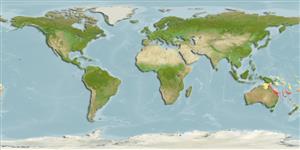Teleostei (teleosts) >
Perciformes/Uranoscopoidei (Sand dwellers) >
Pinguipedidae (Sandperches)
Etymology: Parapercis: Greek, para = the side of + Greek, perke = perch (Ref. 45335); colemani: Named in honor of Neville Coleman who first discovered this species in Norfolk I..
More on authors: Randall & Francis.
Environment: milieu / climate zone / depth range / distribution range
Ecology
Marine; demersal; depth range 2 - 113 m (Ref. 59349). Subtropical
Pacific: Norfolk Island.
Size / Weight / Age
Maturity: Lm ? range ? - ? cm
Max length : 8.2 cm SL male/unsexed; (Ref. 26156)
A single specimen was collected at a depth of 1.5 m (Ref. 26156).
Life cycle and mating behavior
Maturities | Reproduction | Spawnings | Egg(s) | Fecundities | Larvae
Randall, J.E. and M.P. Francis, 1993. Parapercis colemani, a new pinguipedid fish from Norfolk Island, south-western Pacfiic Ocean. N.Z. J. Mar. Freshwat. Res. 27(2):209-214. (Ref. 26156)
IUCN Red List Status (Ref. 130435)
Threat to humans
Harmless
Human uses
Tools
Special reports
Download XML
Internet sources
Estimates based on models
Preferred temperature (Ref.
123201): 24.1 - 26.4, mean 25.5 °C (based on 72 cells).
Phylogenetic diversity index (Ref.
82804): PD
50 = 0.5000 [Uniqueness, from 0.5 = low to 2.0 = high].
Bayesian length-weight: a=0.00692 (0.00311 - 0.01538), b=3.06 (2.88 - 3.24), in cm total length, based on LWR estimates for this Genus-body shape (Ref.
93245).
Trophic level (Ref.
69278): 3.4 ±0.4 se; based on size and trophs of closest relatives
Resilience (Ref.
120179): High, minimum population doubling time less than 15 months (Preliminary K or Fecundity.).
Fishing Vulnerability (Ref.
59153): Low vulnerability (10 of 100).
